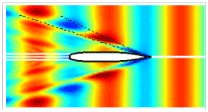Added Resistance in Waves
Backgrounds
Accurate prediction of speed loss due to added resistance is important in the interpretation of speed trials, in the assessment of the sustained speed in specific design conditions like the new “Safe-return-to-port” situations, and in the assessment of the over-all fuel economy of a design. It is very unsatisfactory that current predictions are rather unreliable.
The recent insights obtained in development of the Rankine source method FATIMA may explain why added resistance of ships in waves was notoriously hard to understand and why findings from the past are hard to generalise. The new knowledge offers an excellent opportunity to improve the reliability of the prediction

Objectives
The objectives of the CRS RAW+ project are twofold. First, above Rankine source method will be used to explore the nature of added resistance for specific ship types. The derived insight may be used to improve the performance of these designs in a sea way.
Second, the project investigates specific aspects of the physics of added resistance which are not accounted for in potential theory methods. This investigation, by means of CFD and dedicated scale model tests, will quantify the impact of the breaking of the bow wave (on the downward pitch stroke) and the effects of loss of bulb performance and increased frictional resistance on the added resistance in waves.

Expected Results
For the ship designer very specific deliverables of the project consist of insight in the nature of added resistance for specific ship types and insight in the validity of various prediction methods. More general, the project will yield accurate benchmark data for validation purposes, insight in the prospects of CFD and insight the magnitude of added resistance components which are generally neglected.
